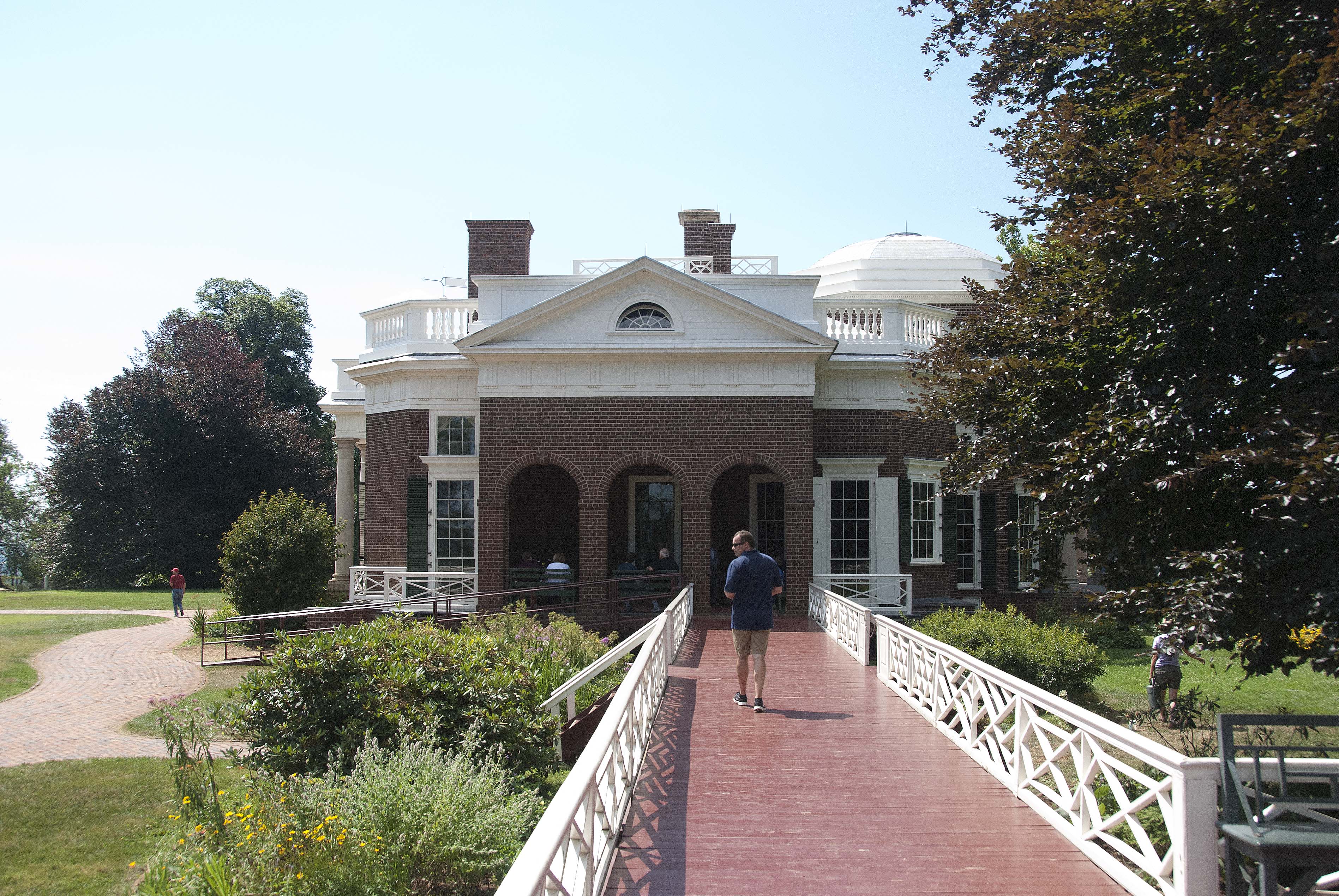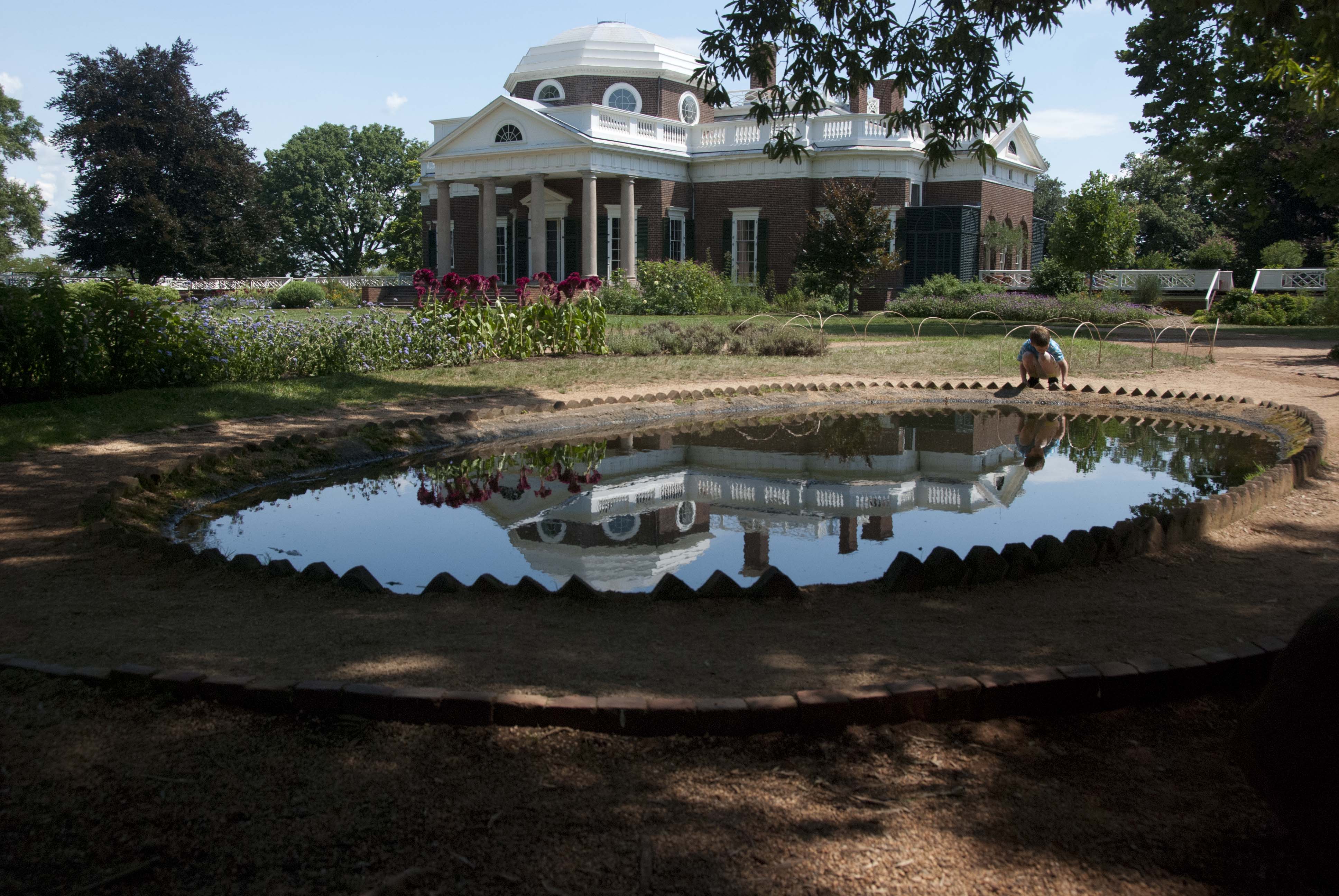
The East Front, the side through which visitors, then and now, enter the building.
Greene County, PA Harper's Ferry, WV Baltimore and St. Michaels, MD Williamsburg and Jamestown, VA Charlottesville, VA
Skyline Drive (Shenandoah National Park), VA Hartford, CT Old Sturbridge Village, MA
Thomas Jefferson, unlike George Washington and many of their Virginian contemporaries, was not a Tidewater Virginian. The lands he inherited from his father are about 120 miles (195 km) northwest of Williamsburg (about two hours by car on the Interstate 64). While it was no longer quite the frontier, it was just inside the first of Appalachian Mountain ridges, the Blue Ridge. While his father built on the plain, Jefferson erected Monticello on top of the mountain looking toward Charlottesville and the Blue Ridge.
Jefferson, like his older contemporary Benjamin Franklin, was a polymath. Just about everything interested him. While Franklin had an international reputation as a scientist, Jefferson was interested in design -- his house and furnishings, the plantation's landscape and agriculture, the country's future direction. John admits it -- both Franklin and Jefferson have been particular favorites of his from his youth.
Jefferson was a man of conflicts as his ideals collided with the practicalities of the new country and its several cultures. We've seen how the issue of separation of church and state had other consequences. He thought the slavery should be ended but realized that it could not be done in his lifetime -- indeed he owned a plantation with slaves and fathered children by one of his slaves. He remains a controversial figure because of this.
Jefferson was proudest of the three acts he specified for his monument:
He was also
He was obsessive about books. At one time, he owned 12% (yes one of eight) books in North America at a time when books were expensive and imported. His second library of more than 6000 books was sold for $23,950 in 1815 to the country as the basis of the Library of Congress after Washington had been burned by the British in 1814. The LOC now holds 158 million items but still pays homage to Thomas Jefferson.
We can't say any better than the following paragraph from the website's Mountaintop Project page:
"Monticello is Jefferson’s three-dimensional autobiography, and the only U.S. Presidential and private home in the United States recognized by UNESCO as a World Heritage Site. All of Monticello’s preservation projects begin with painstaking study of Jefferson’s extensive documentary records, analysis of the building itself, and study of the grounds. Ninety-percent of what you see in the House is original to Jefferson’s time. Two-thirds of the furnishings on view in the House are Jefferson’s originals. Archaeologists have spent fifty years of research revealing the landscape of slavery on the mountaintop. Monticello is the best documented, best preserved, and the best studied plantation in North America. Thanks to these efforts it is an incomparable site for American storytelling through landscape and architecture."
Monticello is privately owned by a foundation, although it was offered to the nation before the Civil War. Nearly a half million visitors a year come to the site. Photographiy in the building is prohibited without specific reason being given. Go to the website for views inside. The tours are VERY closely scheduled with one tour following another into each ground floor room. While this is necessary due to the visitor volume and the small size of the individual rooms, it seriously undermines appreciation of the details. A longer tour including the upstairs rooms is available for an additional fee but definitely requires advance reservations. It just didn't fit into our schedule.
John visited Monticello fifty years ago in the midst of the Civil Rights struggles. Slavery was confronted then but it is much more prominently discussed now. The parentage of the Hemings children is much more certain with the advent of DNA testing. More of the working part of the plantation has been exposed since the 1960s.
Monticello is filled with books and gadgets:
It is filled with books and gadgets, see the rooms individually for a more complete list of contents.
Now the pictures we could take.

The East Front, the side through which visitors, then and now, enter the building.

The North Side atop one the porticos and working areas.

The West Front (the "nickel side")

The kitchen

Jefferson's grave